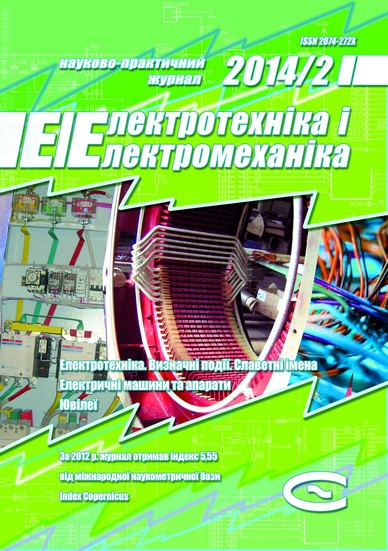A 2-pole winding development technique for asynchronous machines with increased number of parallel branches
DOI:
https://doi.org/10.20998/2074-272X.2014.2.09Keywords:
asynchronous machine, 2-pole winding, parallel branch, EMF, winding factorAbstract
A 2-pole winding development technique is introduced for asynchronous machines with the number of parallel branches in phases increased in 1.5 and 2 times as compared with the number of poles. The technique is confirmed by results of pilot studies.
References
Gurin Ya.S., Kuznetsov B.I. Proektirovanie serij jelektricheskih mashin. Moscow, Energija Publ., 1978. 480 p.
Kopylov I.P., Gorjainov F.A., Klokov B.K. and others. Proektirovanie jelektricheskih mashin. Ucheb. posobie dlja vuzov. Moscow, Energija, 1980. 496 p.
Titov V.V., Hutoreckij G.M., Zagorodnaja G.A. Turbogeneratory. Raschet i konstrukcija. Moscow, Energija, 1967. 895 p.
Titov V.V. Statornye obmotki s uvelichennym chislom parallel'nyh vetvej. Elektrosila, 1979, no.32.
Zherve G.K. Obmotki jelektricheskih mashin. Leningrad, Energoatomizdat. Publ., 1989. 400 p.
Lushchyk V.D. Universal method of winding coefficients calculation. Electrical engineering & electromechanics, 2011, no.1, pp. 28-31.
Downloads
Published
How to Cite
Issue
Section
License
Copyright (c) 2015 V. D. Lushchik, V. O. Tymoshchenko

This work is licensed under a Creative Commons Attribution-NonCommercial 4.0 International License.
Authors who publish with this journal agree to the following terms:
1. Authors retain copyright and grant the journal right of first publication with the work simultaneously licensed under a Creative Commons Attribution License that allows others to share the work with an acknowledgement of the work's authorship and initial publication in this journal.
2. Authors are able to enter into separate, additional contractual arrangements for the non-exclusive distribution of the journal's published version of the work (e.g., post it to an institutional repository or publish it in a book), with an acknowledgement of its initial publication in this journal.
3. Authors are permitted and encouraged to post their work online (e.g., in institutional repositories or on their website) prior to and during the submission process, as it can lead to productive exchanges, as well as earlier and greater citation of published work.





